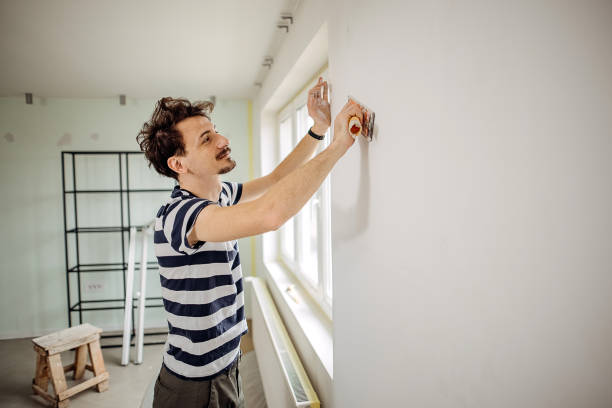Commercial painting is more complex than residential painting and requires more planning and resources. The commercial building painting process involves surface cleaning, minor repairs, paint selection, and professional execution to achieve a durable finish. Selecting the right paint finish for commercial spaces is important, as different areas may require different levels of gloss and durability. Tailoring the project to meet specific needs, like corporate branding colors or safety standards, is essential. OMG Painting specializes in designing a welcoming and polished space for businesses with high-quality exterior painting.
The Ultimate Guide to Commercial painting services- What you Should Know
Are you a business owner looking to refresh your office? Commercial painting involves unique challenges, and key considerations include surface preparation, paint selection, safety measures, compliance, and minimizing disruptions to business operations to ensure a smooth and successful commercial painting project. Commercial painting stands out due to its focus on professionalism, durability, and creating a positive brand image for businesses.

Here is your complete guide to the commercial building painting process.
Project planning and assessment
- Scope assessment:
Determine the extent of the paint project, including the surface to be painted and any special features or challenges. Painting office buildings, warehouses, retail stores, or industrial complexes requires more planning and resources, a larger team, and specialized equipment.
- Timeline and scheduling:
Establish a realistic timeline, considering special disruptions to the business operations and scheduling the project during optimal times.
- Budget and cost breakdown:
Obtain detailed estimates from multiple contractors, including the labor, materials, and any necessary equipment rentals. Commercial painting is usually cheaper per square meter due to the larger scale, depending on specific project requirements.
- Legal and environmental considerations:
Ensure compliance with relevant regulations and consider using low or zero-VOC paints for environmental friendliness.
Surface preparation
- Cleaning:
Thoroughly clean all the surfaces and remove all the grime, dust, mold, and mildew. This may include power washing.

- Repairs:
Address any structural issues like cracks, holes, or damaged surfaces before painting.
- Caulking and sanding:
Fill gaps and imperfections with caulk and sand surfaces for a smooth finish.
- Priming
Apply a high-quality primer to ensure proper paint adhesion and durability.
Paint selection and application
- Choosing the right paint:
Select durable, high-quality, easy-maintenance paints designed for commercial use and suitable for high-traffic areas. Consider factors like washability, stain resistance, and longevity.
- Color selection:
When choosing paint color, carefully consider the desired aesthetic and brand image. Selecting the right finish is also important, as different areas require varying levels of gloss and durability.
- Professional application:
Employ experienced commercial painters who can ensure proper application techniques, including even coats and appropriate drying times. The finish needs to be robust and resistant to wear and tear.
| Interesting factRobotic systems and drone technology are being introduced for complex commercial painting tasks. |
Safety and compliance
- Safety standards:
Adhere to strict safety protocols during the painting process, proper use of scaffolding, ladders, and personal protective gear
- Communication:
Communicate with employees, customers, and stakeholders about potential disruptions and project progress. An aesthetically pleasing environment can boost employee morale and productivity.
Post-painting care
- Cleanup:
Ensure a thorough cleanup of the work area after painting, removing any leftover materials and debris. A visually appealing place can attract customers and create a welcoming atmosphere.
- Final walkthrough:
Conduct a final walkthrough with a painting contractor to address any touch-ups and concerns.
- Regular maintenance:
Establish a schedule for regular maintenance and repainting to maintain the building’s appearance and integrity. Quality painters offer guarantees and warranties on their projects, providing clients with peace of mind.
| Did you know?Innovations in virtual and augmented reality are being incorporated into the commercial painting process, allowing for better visualization and planning of projects. |
Conclusion
Commercial painting is a strategic investment to improve the appearance of your business, protect the structure, and support the brand. Choosing colors that attract customers and align with the business brand identity, and finishes that are easy to clean and maintain, is crucial. Key aspects include assessing the building’s condition, choosing the right color scheme, meticulous surface preparation, and attention to detail to ensure a long-lasting, visually appealing finish that reflects well on the business.
FAQs
1. What makes commercial painting different from residential painting?
Commercial painting involves larger spaces, strict safety protocols, and higher durability standards.
2. How do I choose the right paint for my commercial building?
Select commercial-grade paint with durability, washability, and finish suited to each area’s traffic and purpose.
3. How can I minimize disruptions during a commercial painting project?
Plan the project after hours or on weekends and maintain clear communication with staff and customers.
4. Is surface preparation really necessary for commercial painting?
Yes, cleaning, repairing, and priming are essential for long-lasting, professional results.
5. How often should a commercial building be repainted?
It depends on usage and exposure, but typically every 5–10 years with regular maintenance.

